For the short term, a little more upwards movement was expected to unfold. A close today below the channel on the daily chart after some downwards movement shifts this view.
Summary: The downwards trend may have resumed. Strong confidence in this view may be had if the channel on the daily chart is breached by a full daily candlestick below and not touching the lower edge. While this has not yet happened, risk remains at 1,345.90.
The Elliott wave target is at 1,220. A target calculated using the flag is about 1,236.
Three long-term targets are now calculated for cycle wave c to end. Confidence in a new downwards trend may be had with a new low below 1,160.75.
New updates to this analysis are in bold.
Grand SuperCycle analysis is here.
Last monthly charts are here. Video is here.
MAIN ELLIOTT WAVE COUNT
WEEKLY CHART – TRIANGLE
This is the preferred wave count.
Cycle wave b may be a complete regular contracting triangle. If it continues further, then primary wave E may not move beyond the end of primary wave C above 1,365.68.
Four of the five sub-waves of a triangle must be zigzags, with only one sub-wave allowed to be a multiple zigzag. Wave C is the most common sub-wave to subdivide as a multiple, and this is how primary wave C for this example fits best.
There are no problems in terms of subdivisions or rare structures for this wave count. It has an excellent fit and so far a typical look.
This wave count would expect a cycle degree trend change has recently occurred. Cycle wave c would most likely make new lows below the end of cycle wave a at 1,046.27 to avoid a truncation.
Primary wave E should exhibit reasonable weakness as it comes to an end. Triangles often end with declining ATR, weak momentum and weak volume.
If this weekly wave count is correct, then cycle wave c downwards should develop strength, ATR should show some increase, and MACD should exhibit an increase in downwards momentum.
Three targets are calculated for cycle wave c. Cycle wave a lasted 4.25 years. Cycle wave b may be over in 3.17 years. Cycle wave c may last a minimum of 2 years and possibly up to 5 years.
DAILY CHART – TRIANGLE
Cycle wave c must subdivide as a five wave structure, either an impulse or an ending diagonal. An impulse is much more common and that shall be how it is labelled unless overlapping suggests a diagonal should be considered.
A new trend at cycle degree should begin with a five wave structure on the daily chart, which will be labelled minor wave 1.
Minor wave 2 is now labelled as a complete triple zigzag.
Draw a best fit channel as shown on the daily chart and copy it over to the hourly chart. When this channel is breached by a full daily candlestick below and not touching the lower edge, that may provide confidence that minor wave 2 is over and minor wave 3 has begun. Today price has closed below the channel and the channel is breached now on the hourly chart. However, it is not yet fully breached on the daily chart.
If the channel is breached on the daily chart, then the invalidation point may move down to the end of minor wave 2. While the channel has not yet been fully breached, the invalidation point must remain at 1,345.90.
Minor wave 2 may not move beyond the start of minor wave 1 above 1,345.90. The invalidation point will remain the same while price remains within the channel. The risk that minor wave 2 may still continue higher remains.
HOURLY CHART
Minor wave 2 now fits best as a triple zigzag, which may have been complete at the last high. Triple zigzags are uncommon, but they are not extremely rare.
The best fit channel is now breached on the hourly chart. This is the earliest indication that minor wave 2 may now be over and minor wave 3 may now have begun.
A target is calculated for minor wave 3 that expects it to exhibit the most common Fibonacci ratio to minor wave 1.
Minor wave 3 may only subdivide as an impulse. Within the impulse, minute wave ii may not move beyond the start of minute wave i above 1,323.61.
WEEKLY CHART – DOUBLE ZIGZAG
It is possible that cycle wave b may be an incomplete double zigzag or a double combination.
The first zigzag in the double is labelled primary wave W. This has a good fit.
The double may be joined by a corrective structure in the opposite direction, a triangle labelled primary wave X. The triangle would be about four fifths complete.
Within multiples, X waves are almost always zigzags and rarely triangles. Within the possible triangle of primary wave X, it is intermediate wave (B) that is a multiple; this is acceptable, but note this is not the most common triangle sub-wave to subdivide as a multiple. These two points reduce the probability of this wave count.
Intermediate wave (D) may be complete. The (B)-(D) trend line is almost perfectly adhered to with the smallest overshoot within intermediate wave (C). This is acceptable.
Intermediate wave (E) should continue to exhibit weakness: ATR should continue to show a steady decline, and MACD may begin to hover about zero.
Intermediate wave (E) may not move beyond the end of intermediate wave (C) below 1,160.75.
This wave count may now expect downwards movement for several weeks.
Primary wave Y would most likely be a zigzag because primary wave X would be shallow; double zigzags normally have relatively shallow X waves.
Primary wave Y may also be a flat correction if cycle wave b is a double combination, but combinations normally have deep X waves. This would be less likely.
This wave count has good proportions and no problems in terms of subdivisions.
Intermediate wave (E) should subdivide as a zigzag labelled minor waves A-B-C. Zigzags subdivide 5-3-5, exactly the same the start of an impulse.
The preferred wave count labels downwards movement minor waves 1-2-3, and this wave count labels downwards movement minor waves A-B-C. At the daily and hourly chart levels, the subdivisions for both wave counts are seen in the same way.
ALTERNATE ELLIOTT WAVE COUNT
WEEKLY CHART
If Gold is in a new bull market, then it should begin with a five wave structure upwards on the weekly chart. However, the biggest problem with this wave count is the structure labelled cycle wave I because this wave count must see it as a five wave structure, but it looks more like a three wave structure.
Commodities often exhibit swift strong fifth waves that force the fourth wave corrections coming just prior to be more brief and shallow than their counterpart second waves. It is unusual for a commodity to exhibit a quick second wave and a more time consuming fourth wave, and this is how cycle wave I is labelled. The probability of this wave count is low due to this problem.
Cycle wave II subdivides well as a double combination: zigzag – X – expanded flat.
Cycle wave III may have begun. Within cycle wave III, primary wave 1 may now be complete. The target for primary wave 2 is the 0.618 Fibonacci ratio of primary wave 1. Primary wave 2 may not move beyond the start of primary wave 1 below 1,160.75.
A black channel is drawn about primary wave 1. Primary wave 2 may breach the lower edge of this channel.
Cycle wave III so far for this wave count would have been underway now for 27 weeks. It should be beginning to exhibit some support from volume, increase in upwards momentum and increasing ATR. However, volume continues to decline, ATR continues to decline and is very low, and momentum is weak in comparison to cycle wave I. This wave count lacks support from classic technical analysis.
TECHNICAL ANALYSIS
WEEKLY CHART
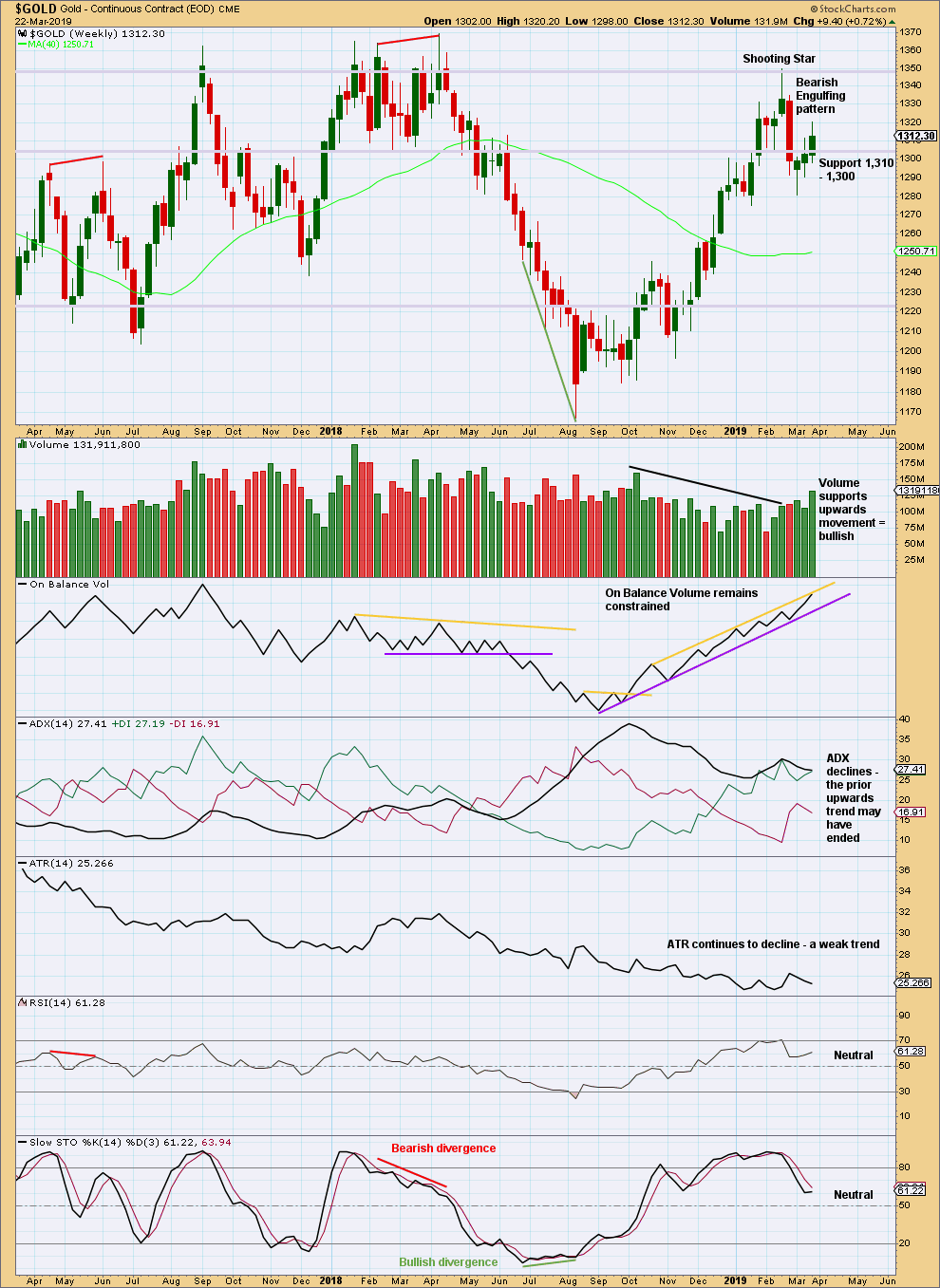
Click chart to enlarge. Chart courtesy of StockCharts.com.
Support from volume for upwards movement suggests more upwards movement this week.
Support about 1,310 – 1,300 was breached by downwards movement, and resistance there has now been breached by upwards movement. This area of prior strong support and resistance has by now been weakened.
DAILY CHART
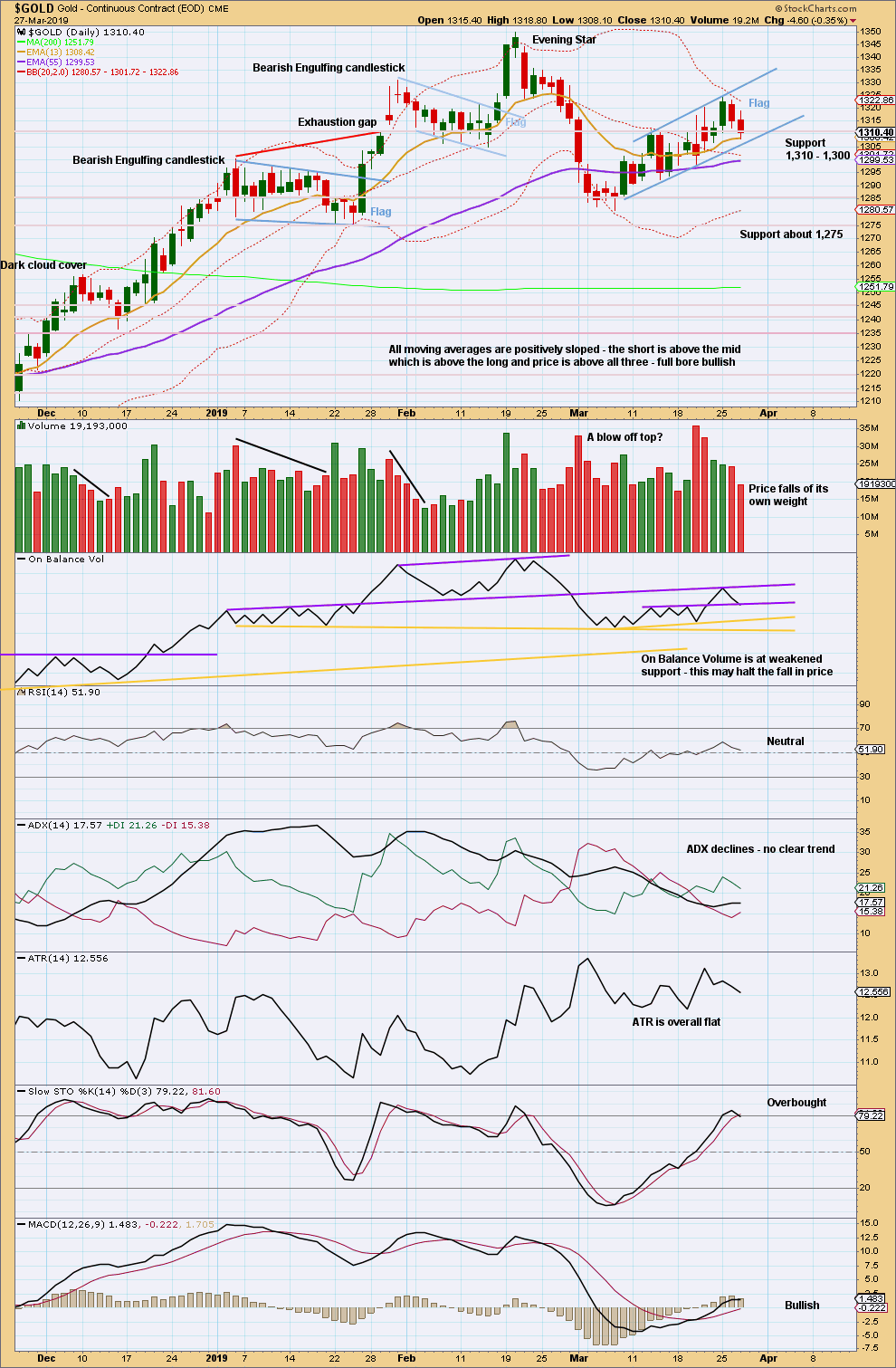
Click chart to enlarge. Chart courtesy of StockCharts.com.
The flag pattern remains valid. The best performing flags and pennants complete within 14 sessions. So far this one has lasted 14 sessions. Flags are reliable continuation patterns. A downwards breakout would be expected. The target calculated using the flag pole is about 1,236.
From the major low in August 2018 (not shown on this chart) there was a series of higher highs and higher lows up to the last high on the 20th of February 2019. This upwards trend remained intact until the last swing low on the 14th of February was breached by a new swing low on the 1st of March. At that point the larger picture of an upwards trend switched to either neutral or a new downwards trend. For any confidence the prior upwards trend remains intact a new high above the February 20th high is now required. While that high remains intact, it is possible that there has been a trend change. A new low now below the low of the 7th of March would add confidence there is a new downwards trend in place.
Today On Balance Volume is at weak support. A breach of this trend line would provide a weak bearish signal.
GDX WEEKLY CHART
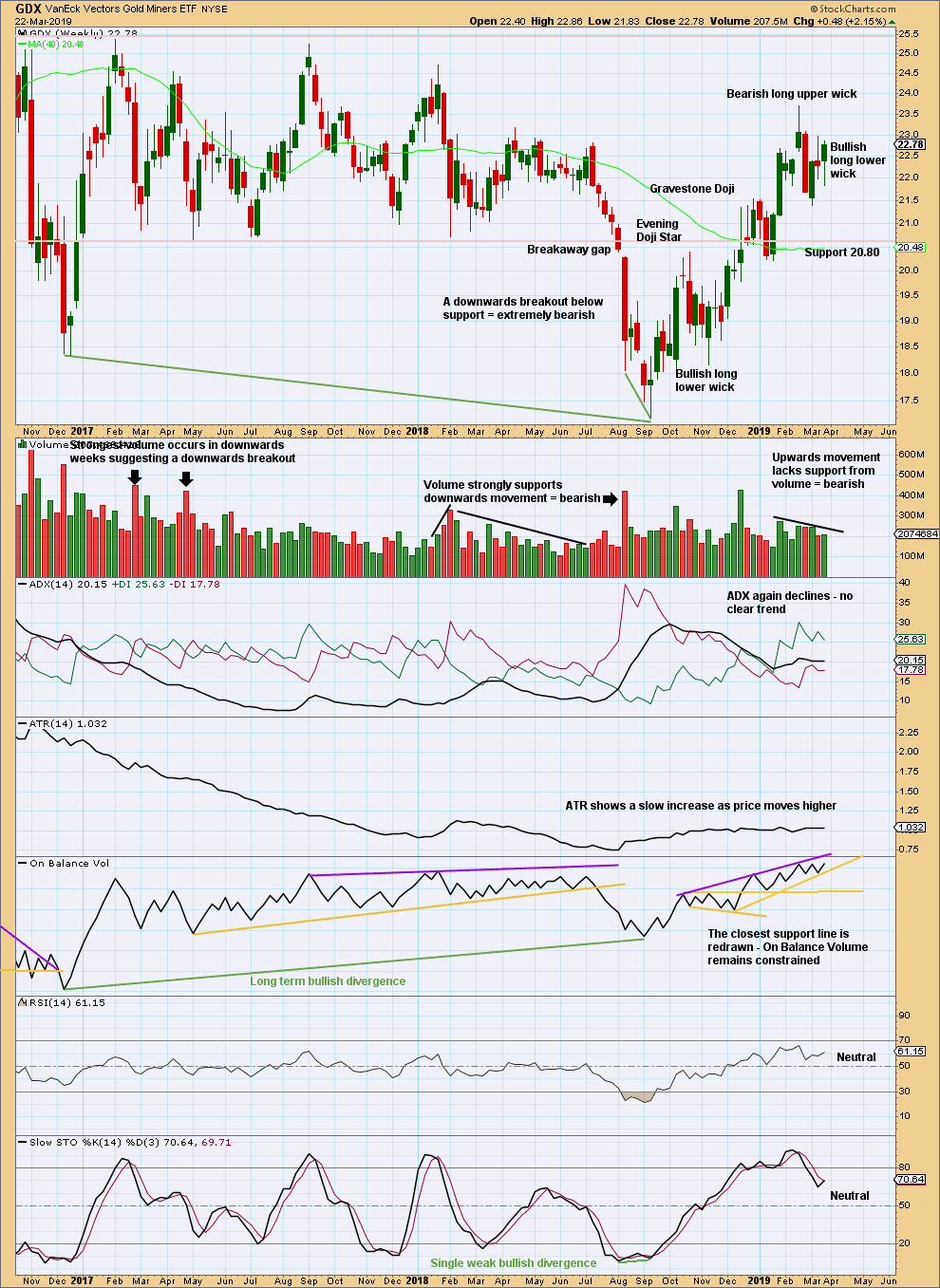
Click chart to enlarge. Chart courtesy of StockCharts.com.
A new swing low below the prior low of the week beginning 22nd January at 20.22 would confirm a trend change. For now GDX may be assumed to remain in an upwards trend. There is a series of higher highs and higher lows from the low in September 2018.
For the short term, a bullish long lower wick and price closing near the high for the week suggest more upwards movement.
GDX DAILY CHART
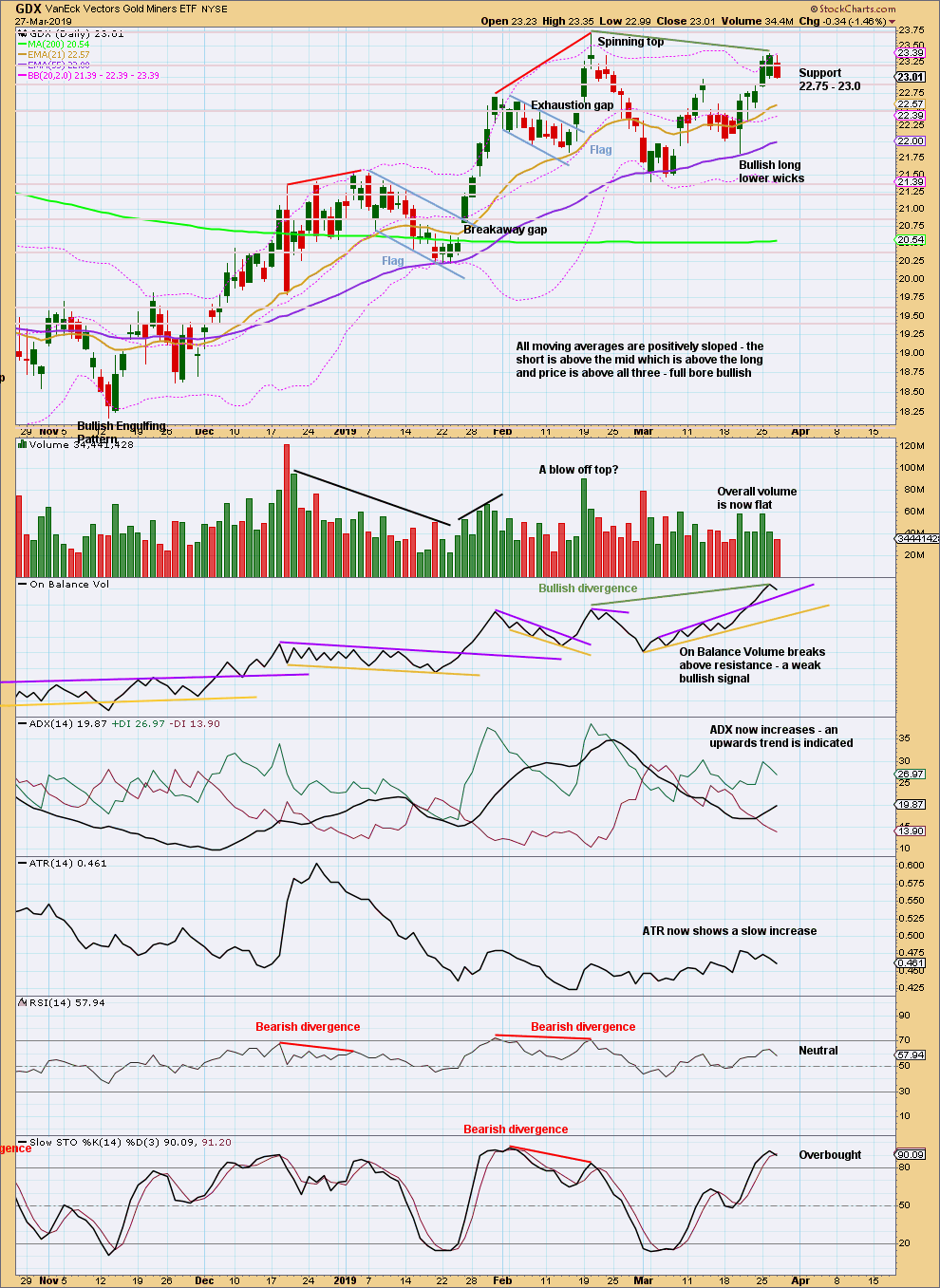
Click chart to enlarge. Chart courtesy of StockCharts.com.
Price has closed above resistance at 23 on an upwards day with support from volume. This is a classic upwards breakout. Next resistance is about 23.75.
GDX looks more clearly bullish than Gold.
Published @ 07:54 p.m. EST.
—
Careful risk management protects your trading account(s).
Follow my two Golden Rules:
1. Always trade with stops.
2. Risk only 1-5% of equity on any one trade.

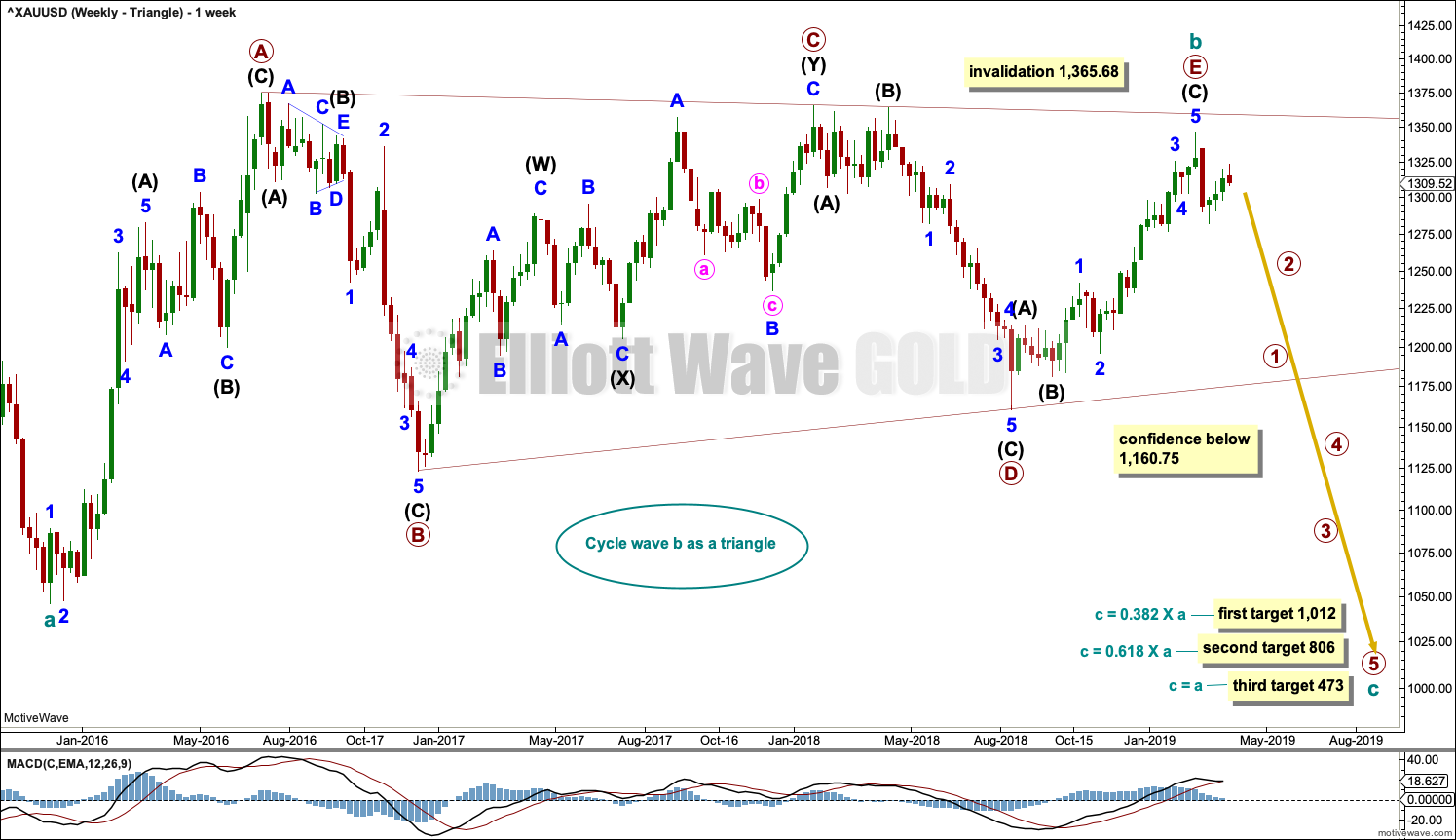
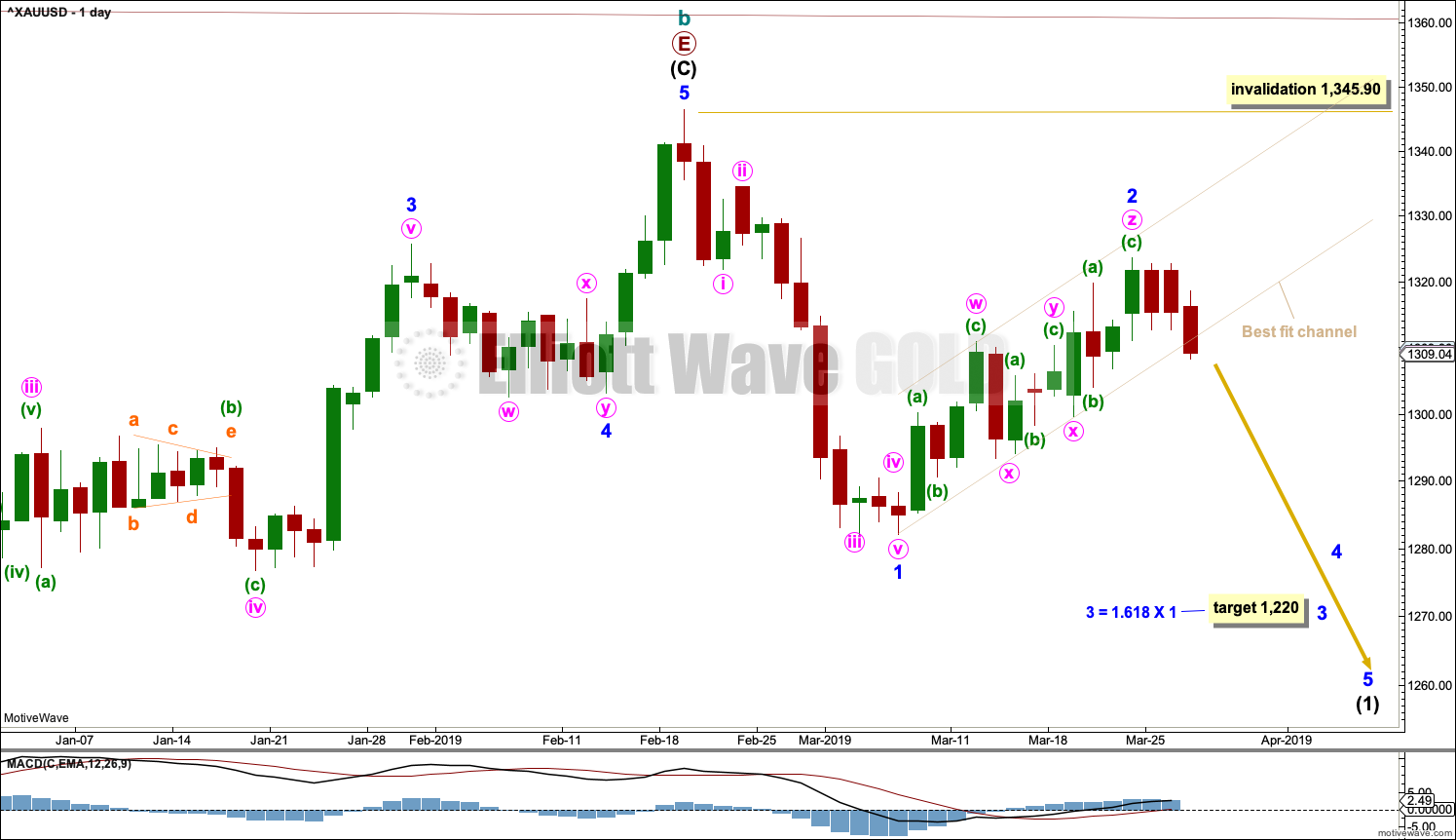
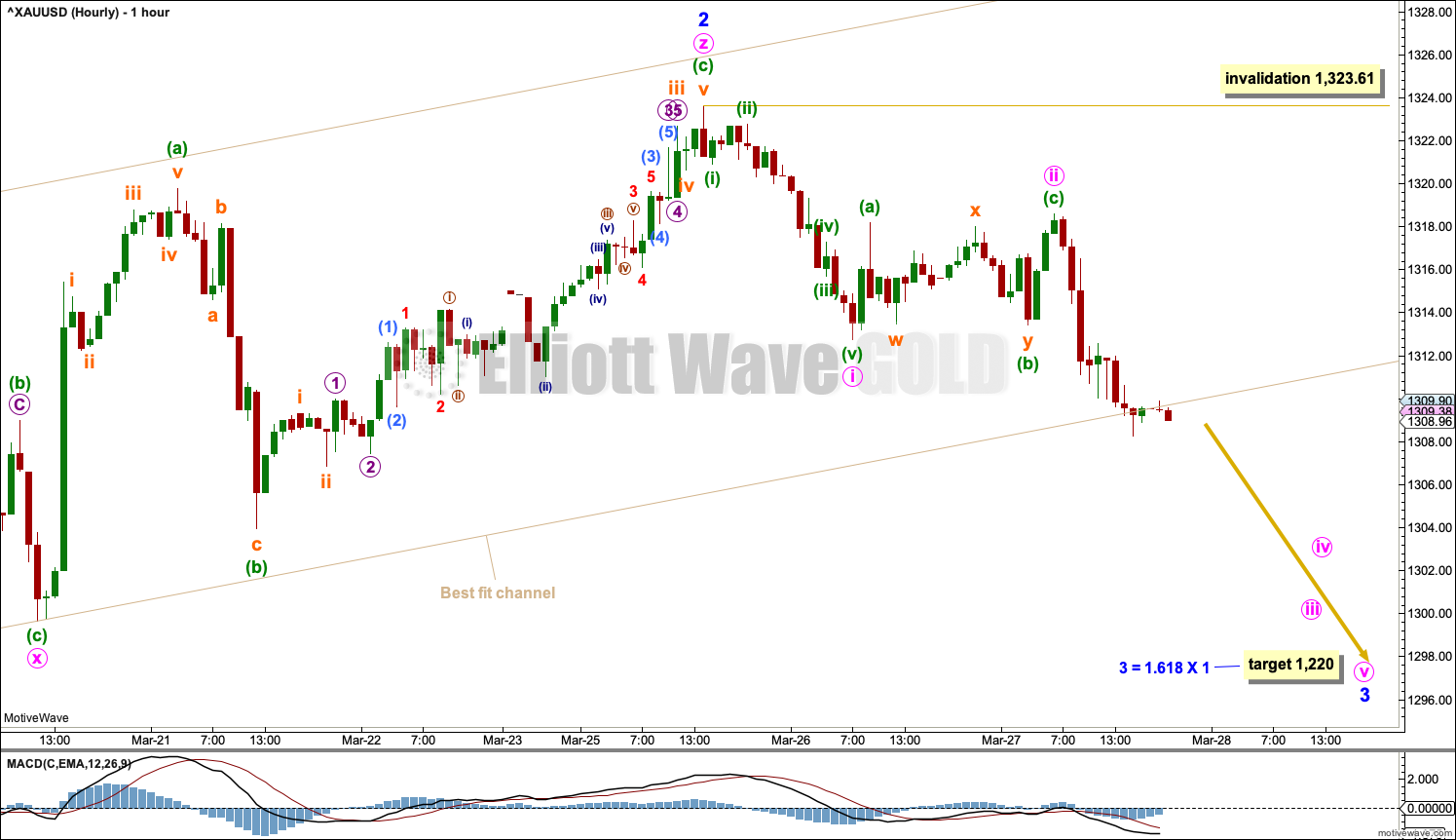
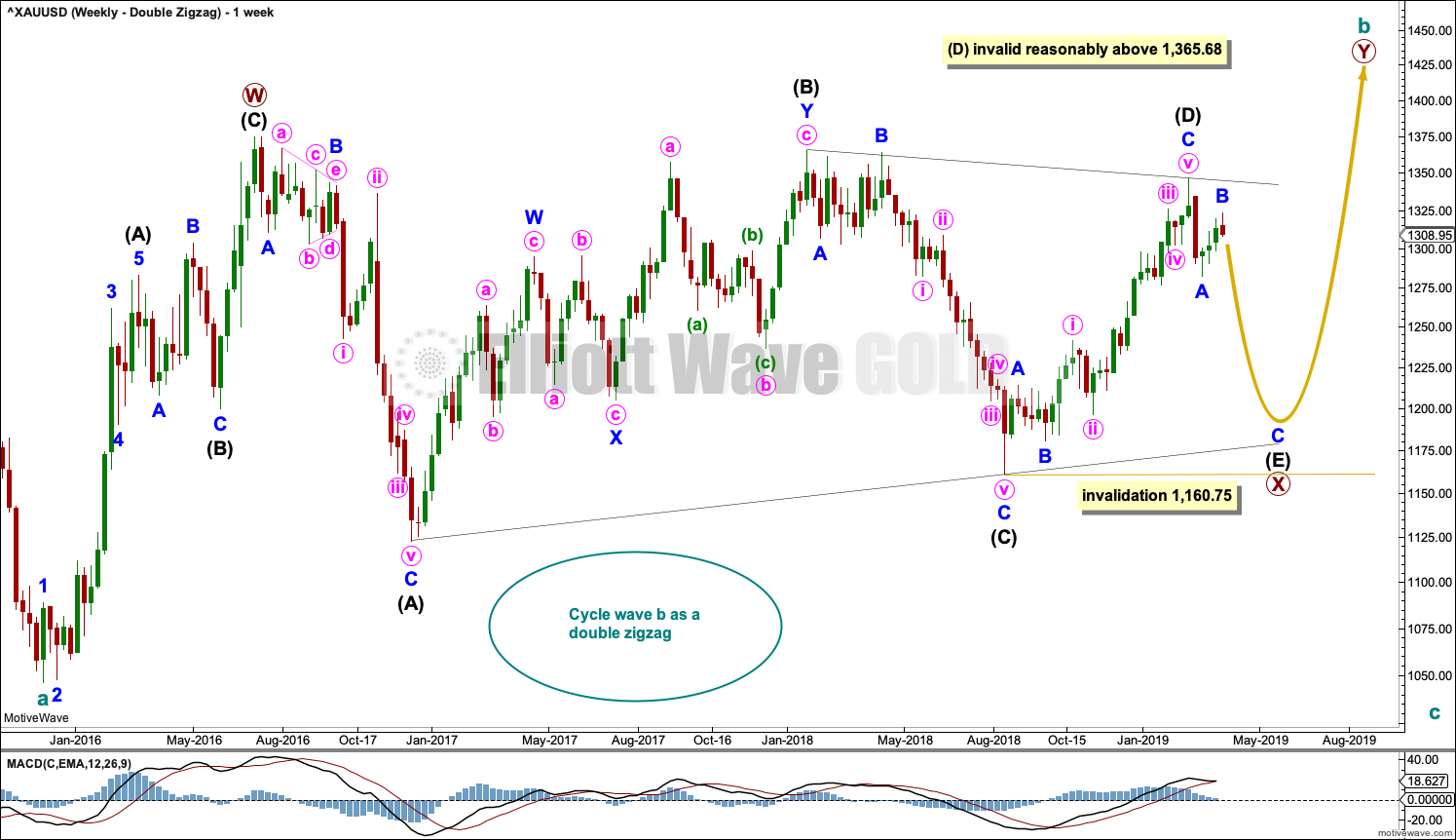
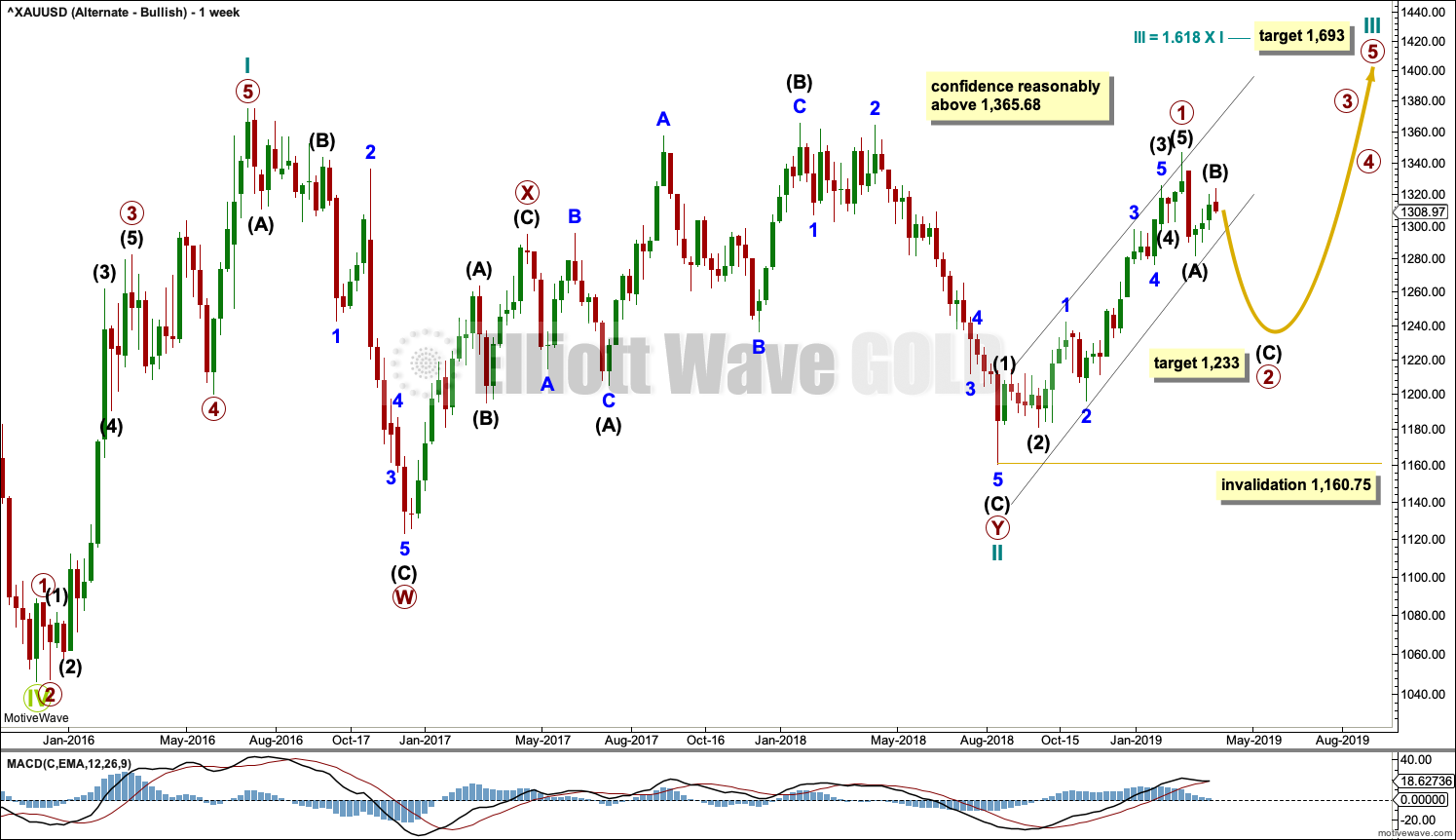
This daily candlestick will be very strong and will be a full breach of the upwards sloping channel that contained minor wave 2.
Targets remain the same.
The short term invalidation point can be moved lower. I’m now labelling minute i within minor 3 as incomplete. Within minute wave i, minuette wave (iv) may not move into minuette wave (i) price territory above 1,312.77.
Hi Lara
So what’s the value today Gold can’t breach, to be a clear day below the trend line?
Still long, (after being short, but taking a punt on 1330 – doh), and don’t want to turn around again until I know its the right thing to be doing.
The channel was breached on the hourly chart yesterday. In this analysis I expected Gold to move lower, and it has. I’m really concerned you held onto a long position after that.
Today the channel will be fully breached at the daily chart level. That adds strong confidence the downwards trend has resumed.
It wasn’t a price point, it was a channel. I can’t give you a price point because the trend line is sloping and so the price point changes with time.
Yep, I was all short the other day, but I must have misunderstood all the talk of a triple ZZ, and went long – left it too long long hoping for a bounce and finally got out at 1300(ISH) – costly few days – but hopefully can make it all back now.
It’s always a good idea to trade with the trend.
Minor degree corrections can last several days, but the degree is really too low for a confident trade.
When Gold made a lower low on 28th February, that was the day we could have a little confidence in a new downwards trend. At that stage the larger trend was down.
If trying to trade smaller counter trend movements it would be best to take profits quickly, and cut losses short. And only for most experienced traders.
Here’s a short article on what I mean. You’ll find a bunch of other useful stuff in the Education category. Access it via the drop down menu on the RH sidebar of the site which you can see when you’re inside a post.